
The key to being a successful investor is to maximize your gains and minimize your losses. It sounds so simple, yet most investors do the opposite. Most investors sell their winners too soon and hold on to their losers too long. To be successful you want to be patient with your winners and impatient with your losers.
We have 5 basic steps that we recommend subscribers follow:
- Take full responsibility for your investments – “it’s your money – take control”
- Before you buy any stock or Exchange Traded Fund (ETF), have an exit strategy
- Decide before you buy – what is the maximum you are willing to lose before you sell? Is it 5%, 10%, 15%, 25%, more? Pick a number and stick to it. This is your SELL Stop.
- If your stock or ETF declines and hits your SELL Stop, SELL! Do not talk yourself out of selling. Take your loss and move on.
- If the stock rises, then continue to raise your SELL Stop
- On winning trades, protect your profits using trailing SELL Stops by raising your SELL Stops as the stock price rises
Example:
In August of 2011 we hit our SELL Stops on gold after riding a glorious bull market from 2002 to that August 2011 top. One of the factors in turning bearish on gold was that we were looking for the $US to turn bullish.
On April 27, 2014 as a way to play a strong $US we recommended that subscribers buy the ProShares Ultra Short Euro ETF (EUO), which is 2X inverse to the $US. For every 1% gain in the $US, this ETF is designed to gain 2%. (Note that the reverse is also true, a 1% decline in the $US would result in a 2% loss for EUO). This is a trade we have done several times with success.
At the time we recommended this trade, EUO was trading at 16.76. We were quite confident that the price would turn higher, but we needed to decide what our exit strategy would be if we were wrong. Because our models were so strongly bullish on this trade, we set a very tight SELL Stop at 16.00, which was about 4.5% below the entry price. That was all we were willing to lose if this trade turned against us.
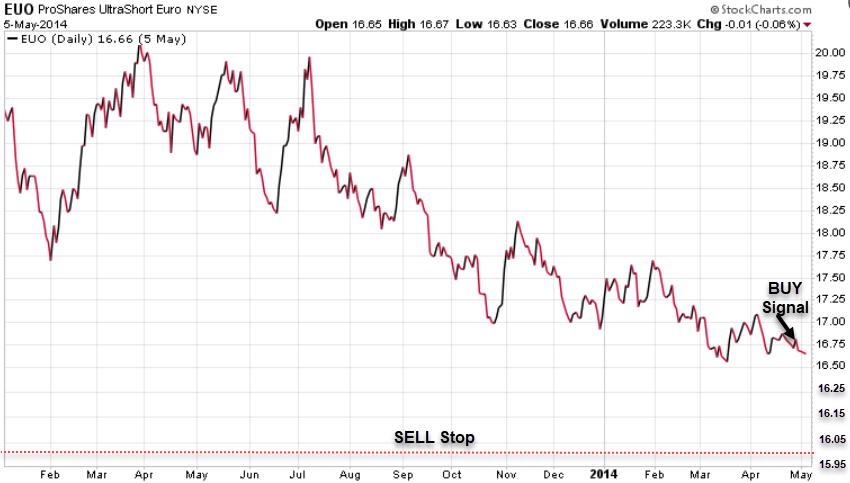
A side note that Canadian investors need to consider.
EUO is a US ETF which we must buy in $US dollars. At the time of that trade the $US dollar to $CAD dollar exchange was $1.1027, meaning that for every $10,000 US we invest in the ETF, it would cost us $11,027 $CAD.
This trade worked out particularly well, as the $US gained strength against the Euro, and EUO gained 2X that amount. By mid June EUO was trading at 17.81, up about 6% from our BUY Signal. We then raised our SELL Stop to what we originally paid, which meant that if EUO were to top out and head down from 17.81 we would sell at the same price we bought, for no gain or loss.
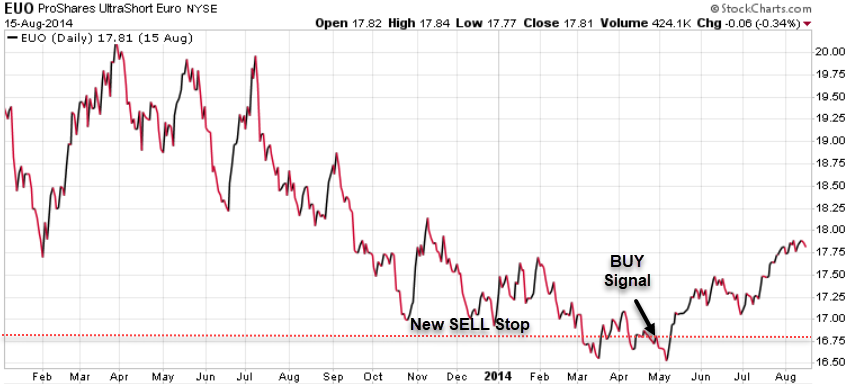
EUO continued to move higher and on October 4, 2014 EUO closed the week at 20.38, up 21.60% from our purchase price. We again raised our SELL Stop but given that EUO was rising so quickly we wanted to give it more leeway on a pullback. We then raised our SELL Stop to 18.35, which was 10% from the high. If EUO were to drop down and hit our 18.35 SELL Stop we would SELL and be happy with a 9.45% gain.
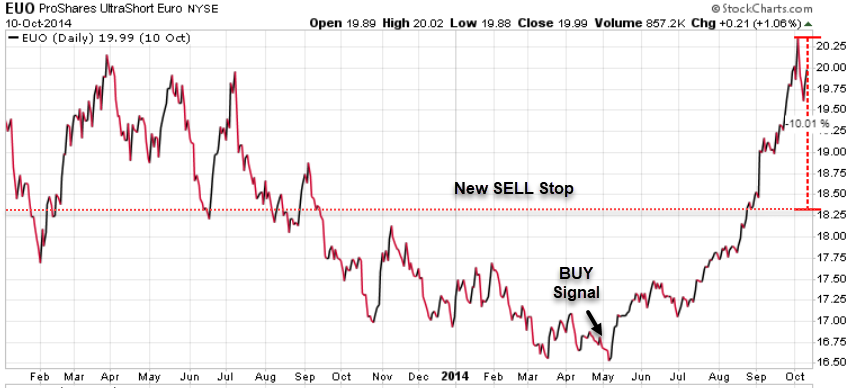
As we predicted, the $US dollar continued to gain against the Euro, pushing up our EUO trade to over 28.00 on March 13, 2015. At this point this trade was getting overbought so we tightened our SELL Stop to 26.00 (about 8.5% from the high).
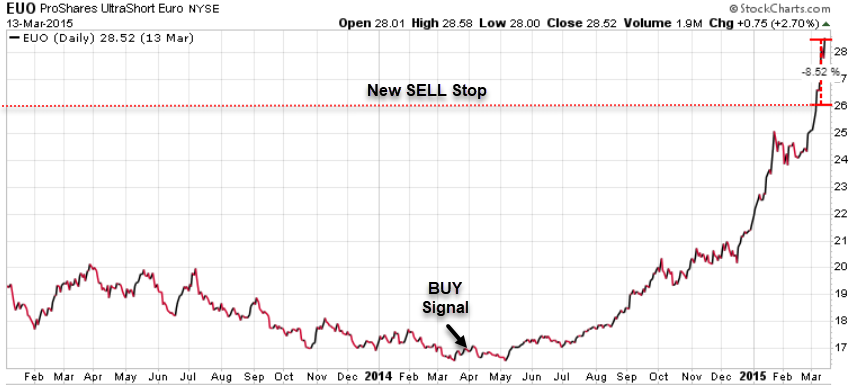
On March 23, 2015 our SELL Stop was hit, and we SOLD out of the EUO trade.
Using trailing SELL Stops is a simple but incredibly effective tool to allow your winning trades to continue higher, while at the same time protecting your profits. In the example we used here if when we first entered EUO it dropped below our original SELL Stop we would have sold and taken the 4.5% loss, which we pre-determined was a reasonable risk versus the potential upside reward. As EUO kept rising we protected our profits by continuing to raise our SELL Stop.
While using trailing SELL Stops will not get you out at the exact top, it will get you out at levels that you have decided on ahead of time that you are comfortable with. Would we have rather gotten out at the 28.30 top? – sure, but we got out with a 55% gain in less than a year, which is a solid return.
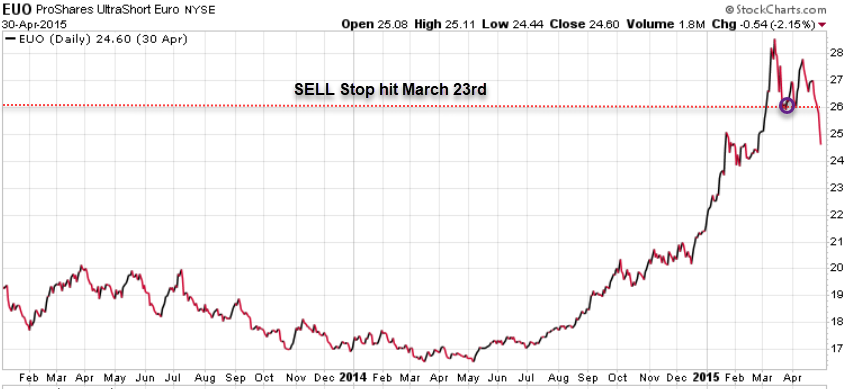
And let’s not forget the gain on the $US currency rise.
On April 27, 2014 it cost us $11,017 CAD for every $10,000 $US we invested in this trade. But on March 23, 2015 the $US was worth 1.252 $CAD dollar. Every $10,000 $US we invested gained 55% ($5,500), which comes to $15,500 $US. Converting this $15,500 $US back to $CAD = $19,406 $CAD for a gain of ($19,406 – $11,017) = $8,389, a rewarding 76% gain using $CAD.
Watch for a much weaker Euro over the next couple of years.
Nothing goes straight up or down, but we firmly believe that the Euro is in for some serious trouble as things start to unravel in Europe. We re-entered the EUO trade last February and that trade is up just under 25% today. In addition, we are sitting on an 8% currency gain with the $US to $CAN exchange.
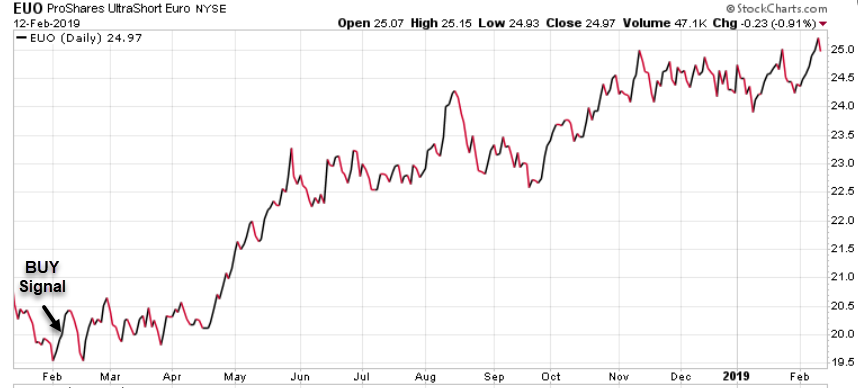
Canadians should consider doing this trade on any significant Euro rally ($US decline). We plan to be in and out of this trade a number of times over the next couple of years.
We are also looking for the Yen to ultimately push much lower and will be buying the ProShares Ultra Short Yen ETF (YCS) to play that move. The Yen often acts as a safe-haven trade early when there is a risk-off sentiment but longer term the Japanese economy will follow Europe into a deep economic decline and debt crisis. When that deep dive begins there will be significant gains to be made being short the Yen.
Also, Canadians should look to accumulate $US dollars anytime the $CAD gets near $.80.
Stay tuned!
